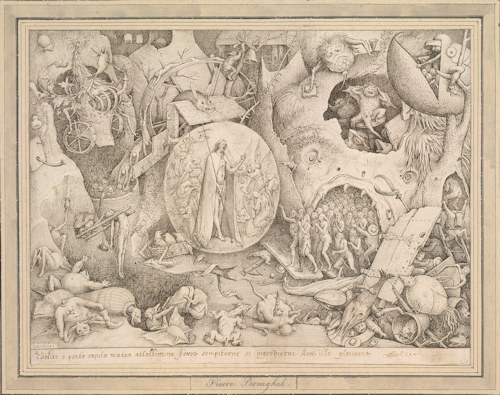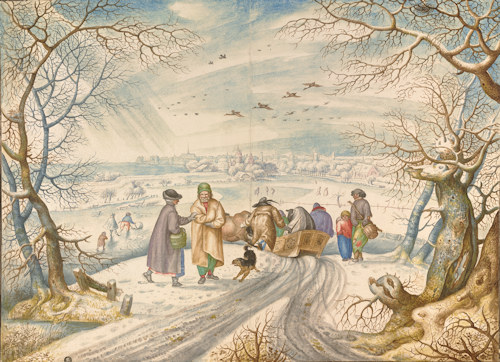
The power of the pen (charcoal, quill, etc.) comes to the fore in a trip back to the Netherlands of the 16th century. The Albertina’s Bruegel and his Time exhibition shines a light on crosshatched shade to expose the delights of the drawing.
- Bruegel, de Beer, Goltzius, and more
- Includes newly-restored works
- Runs Feb 15 – May 24, 2023
- Supported by the Government of Flanders
- All display info in English, too
- See also:
- Albertina overview & info
- Current art exhibitions in Vienna
Drawings come of age

(Pieter Bruegel the Elder; Christ in Limbo, 1561; pen and brown ink; on paper; photo courtesy of and © ALBERTINA, Vienna)
Many regard the years around 1900 as the hotspot of historical Viennese creativity. When it comes to drawing, the Netherlands enjoyed its own notably rich period of innovation and variety in the 16th century. This was the time of Pieter Bruegel the Elder (c. 1525/30-1569).
Across those years, drawings served a growing range of purposes. For example, serving as preliminary sketches and designs for stained glass windows or other items.
And drawings broke away from ecclesiastical themes and portraits to also capture the whirl of change brought about by sociopolitical, economic and religious developments in standalone graphical works.
All these examples came to be appreciated in their own right as true art, creating an appropriate medium and era for an exhibition.

(Jacob Savery I.; Winter Landscape near Amsterdam, c. 1600–1603; pen and brown ink, watercolor, opaque watercolor; on paper; photo courtesy of and © The Albertina Museum, Vienna)
Fortunately, the Albertina just happens to have a collection of suitable drawings in its vast archives. Which allows them to bring us the Bruegel and his Time exhibition, featuring around 90 works.
Bruegel, of course, is one of those names that rank up there with Rembrandt, Michelangelo, and other greats of European art history. Mostly due to paintings such as Hunters in the Snow.
As well as the headline name, however, the exhibition also features such powerful artists as:
- The renowned engraver, Hendrick Goltzius (1558-1616/1617)
- The painter and Master of the Milan Adoration, Jan de Beer (around 1475 – 1528)
- The painter, Maarten van Heemskerck (1498 – 1574), known also for his Wonders of the World engraving designs that gave us an unexpected eighth wonder (Rome’s Colosseum)

(Maarten van Heemskerck; Job Tormented by Satan; pen and light- and dark-brown inks, over charcoal; on paper; photo courtesy of and © The Albertina Museum, Vienna)
As an additional bonus, several of the works on view have just finished the restoration process, so we can admire them in all their pristine glory.
A visit quickly reveals the extraordinary possibilities offered by a pen, tinted paper, ink and talent. Subjects range from monsters to market scenes, costumes to cityscapes. Meaningful texts accompany most of the pieces, so you have a better insight into what you’re looking at.
The show offers many highlights, but here just a couple of personal ones:
- Lucas van Valckenborch’s view of Vienna seen from the Northeast, a pen and wash piece from the end of the 1500s. Utterly charming to ses today’s metropolis as a country town (look for Hans Bol’s drawing of Amsterdam, too)
And a couple of Bruegel works, of course:
- The 1566(?) The Painter and the Buyer, simple but laced with cynicism about the art market of the times
- The 1557 Sloth, a Bosch-like landscape full of skill and imagination that, as with similar Bruegel paintings, draws you deeper into the picture as you discover the details.
Talking Hieronymous Bosch, he has a couple of drawings in the exhibition, too. Notably The Tree Man from the early 1500s, which hints at the fantastical imagination and playfulness of the artist.
Dates, tickets and tips
Travel back in time to the 16th-century Netherlands between February 15th and May 24th, 2023. An entrance ticket from or for the Albertina gets you into the museum and its exhibitions.
Spring 2023 in the Albertina offers another treat in the form of the Dürer, Munch, Miró exhibition, which showcases the evolution of printed graphics. And for a more contemporary take on a similar topic, consider the Albertina Modern’s Andy Warhol to Damien Hirst exhibition.
If you admire Bruegel’s work, be sure to visit the nearby Kunsthistorisches Museum. It owns the world’s most impressive collection of his paintings, which includes Hunters in the Snow mentioned above (you want Saal/Gallery 10 on Ebene/Floor 1).
How to get there
The Albertina features on most walks through the city centre and is easy to reach. See the travel tips at the bottom of the main Albertina article. The exhibition is on level 2 of the museum.
Address: Albertinaplatz 1, 1010 Vienna